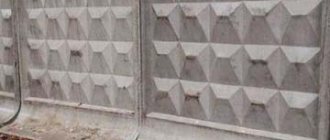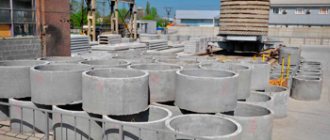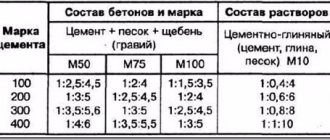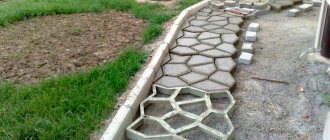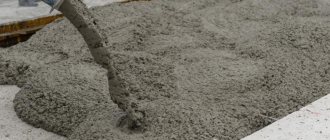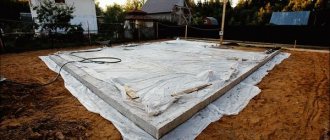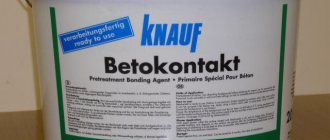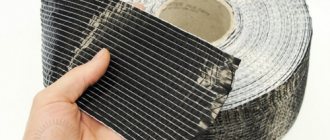CONCRETE WORK, a set of construction works performed during the construction of concrete and reinforced concrete structures and structures. B. r. include the following basics. processes: preparation of the concrete mixture, its transportation to the construction site, supply of the mixture to the place of laying and concreting itself, i.e. laying the mixture into formwork, compacting and creating the necessary conditions for hardening of concrete (“care” of concrete).
Preparation of concrete mixture
The production of concrete with properties that meet the specified requirements is ensured by the quality of the starting materials, the correct and accurate dosage of the components and their uniform mixing. The concrete mixture is prepared in concrete mixers. The components of the mixture (cement, aggregates, water and various additives) are weighed in accordance with the given recipe and fed into concrete mixers automatically. dispensers. Cement, water and additives are dosed with an accuracy of up to 1%, aggregates - up to 2%.
The use of additives is the most universal way to control technological processes. and rheological indicators of concrete mixtures and regulation of concrete properties. Additives are introduced as a percentage of the cement mass; their number depends on the class of concrete and the nature of the concrete work. There are chemical, finely ground active mineral additives and complex mineralochemical additives. Chemical additives are classified based on effect of action. They can be plasticizing (increasing the mobility of mixtures), stabilizing (preventing the separation of mixtures), water-retaining, accelerating or slowing down hardening, ensuring hardening at low temperatures, etc. The most widely used additives are C-3 and Lingopan. Additive C-3 (superplasticizer) increases the mobility and workability of mixtures, reduces water consumption by up to 20% and increases the adhesion of concrete to reinforcement, thereby increasing strength characteristics by up to 50%. Additives like “Lingopan” are not only effective plasticizers, but also increase the rate of strength gain of concrete. Thus, “Lingopan B-2” allows you to obtain up to 60% of the design strength within 24 hours. The use of finely ground additives helps to increase the strength and resistance of concrete to external influences. Complex mineralochemical additive (KMKh) reduces the water permeability of concrete by compacting the structure with a mineral component, increases the frost resistance of concrete, accelerates hardening and increases the strength of concrete.
If the mixing time of the mixture components in the concrete mixer is insufficient, the homogeneity of the concrete deteriorates and its strength decreases. The most effective are forced mixers that mix mixtures for 2–3 minutes.
When constructing buildings and structures made of monolithic reinforced concrete in large cities and areas of concentrated construction, mobile concrete mixers are used, installed in close proximity to the object being built, which allows maintaining technological efficiency. properties of the concrete mixture and minimize transportation costs. Concrete mixing plants are equipped with a microprocessor automation system. control, as well as a system for collecting and processing information on humidity and temperature of aggregates. Based on the data obtained, the mixture recipe is set. The system keeps track of the consumption of mixture components and the production of finished products, and prints passports for the prepared mixture. The most common are concrete mixing plants and mini-plants with a capacity of 10, 20 and 30 m3/h.
Tips and tricks
Carrying out construction procedures of this nature, as a rule, requires the intervention of experienced professionals, as well as the competent selection of the right, reliable and high-quality materials. Our company guarantees qualified execution and control of concrete work, which ensures maximum reliability, safety and durability of finished structures. We offer the best conditions for our clients and, importantly, reasonable prices, and adhere to deadlines for completing work. Contact our consultants for more information.
Concrete mix supply
Concreting of structures with mixture supply by a concrete pump and distribution boom.
The concrete mixture is supplied to the placement site by cranes in buckets with a capacity of 0.5–8 m3, lifts, belt conveyors, concrete pavers, vibrating feeders, and concrete pumps.
Concrete mixture is supplied without overloading when concreting piles, shallow foundations and other structural elements. The mixture from a concrete mixer truck is fed through a tray into receiving funnels or directly into the formwork. In all other cases, the concrete mixture is reloaded into bunkers or buckets and transported by cranes or concrete pumps to the placement site. In the practice of monolithic construction they mainly use. combined a method when concreting of vertical structures (columns, walls, elevator shafts, etc.) is carried out by supplying the mixture with a crane, and concreting of floors is carried out with concrete pumps through a concrete pipeline system. To supply concrete mixture at negative and low temperatures, concrete pipes are insulated.
Components and mixing the solution
Concrete consists of several elements: cement, sand, crushed stone and water; sometimes a plasticizer, anti-corrosion or other additives are added. There is no one universal recipe - proportions may differ for different types of work.
Important: experts recommend using two types of crushed stone - fine-grained and coarse-grained, so the mixture will be denser. The second important point when choosing crushed stone is its strength. The most durable is granite crushed stone. Limestone is used for lightweight concrete.
The article “Fractions and characteristics of crushed stone” will answer the questions in more detail.
Choosing a brand of cement
The overall strength of the product depends on the brand of cement. And this is very important if you are not making a flower box for the dacha, but, for example, a foundation.
The marking of concrete uses the letter M and a three-digit number. The number is the compressive strength in kgf/cm2. Thus, the name M-250 means that the compressive strength is 250 kgf/cm2.
Important: due to the similarity of markings, confusion may arise between concrete and cement. Just remember that M-200 concrete uses M-400 cement, and M-250 concrete uses M-500 cement. M-200 cement itself is used for small-scale construction and household work; it is practically not used for concrete; to create reinforced concrete products, cement starting from grade M-300 is required.
When creating reinforced concrete products, the M-200 grade is used. The formula for it is: 1: 2.8: 4.8 - this is 1 part cement, 2.8 parts sand, 4.8 parts crushed stone. Water makes up 20% of the total volume of the mixture. From 10 liters of M-400 cement, 54 liters of M-200 grade concrete are obtained.
GOST dictates the following composition for the M-200 grade: cement - 265 kg, sand - 860 kg, crushed stone - 1050 kg, water - 180 l, plasticizer - 4.8 kg. Another name for it is B15. Most often, M-400 or M-500 cement is used to create reinforced concrete products, as well as most works. For 10 kg of cement, you can also add 1 kg of frost-resistant additive if you plan to work at sub-zero temperatures.
If you want to do all the work yourself, please note that:
- It will be quite difficult to achieve uniformity on your own - the process requires physical strength and accuracy. If possible, use an electric concrete mixer.
- The mass in the mixing chamber should not occupy more than a third of its volume.
- If you don’t have a concrete mixer, make sure there are no lumps, the mass should be homogeneous.
- Concrete is a quick-hardening mixture, so don't mix large volumes at once unless you're sure you'll need it. Hardening takes 3-5 hours!
- Make sure that the material does not contain debris, foreign objects, wood - when decomposed, organic matter negatively affects the density.
- Do not add excess water under any circumstances, otherwise the solution will not reach the required strength.
- If your site has acidic soil (peaty or marshy soil), then use anti-corrosion additives.
- In winter, use antifreeze additives.
- Do not allow the resulting mass to overheat or freeze.
The process of preparing concrete in a concrete mixer is as follows:
- 10 liters of water are poured into the tank,
- First add gravel or crushed stone, then sand,
- The solution is stirred for 5 minutes,
- Add another 2 liters of water and cement,
- Everything is mixed for another 10 minutes.
Do not turn off the concrete mixer while mixing!
On average, one cycle takes 15 minutes, which makes the use of more than two such units irrational. Hand-held concrete mixers or drill mixers also speed up the work. The main thing is to achieve uniformity.
Concrete delivery is a very popular service. In this case, the solution is delivered ready-made. One machine holds up to 8m3. If necessary, order two cars at once.
This option also has disadvantages:
- Heavy equipment cannot travel everywhere; some objects simply cannot be approached,
- Unscrupulous suppliers can pass off M-200 grade concrete as M-150 grade, taking advantage of the fact that the client does not understand the issue.
- Completely unscrupulous sellers try to deceive you by half a cubic meter - delivering less than you ordered.
- The maximum distance over which delivery by automixer is carried out is 70 km; at a greater distance, the material loses its quality.
- The standard unloading time for most enterprises is 30-40 minutes. If you need more time, you will have to pay for transport downtime, which sometimes significantly increases the price.
Choosing a concrete grade
The article “Grades and classes of concrete” will answer the questions in more detail.
Where is M-200 used?
The most common misconception is that M-200 is suitable for pouring any foundation. This is completely wrong! Concrete M-200 is suitable only for the foundation of light low-rise buildings - houses made of timber, wood, and country houses. Pile and strip foundations are made from it. M-200 is also not used in multi-storey monolithic construction.
If you look closely, you can see coarse and fine gravel.
A logical question arises - why then are floor slabs made from it? We answer:
- Concrete is reinforced with a reinforcement cage.
- Processing in production, which allows you to obtain higher strength.
- The processing includes the use of a vibrating table, which completely eliminates air bubbles, and drying the slabs in a drying oven allows you to quickly achieve a strength of 65-75%, which under normal conditions would only occur in a month.
So, M-200 is suitable for:
- Creation of hollow-core slabs for high- and low-rise buildings (at a reinforced concrete plant),
- Screeds and floors (not to be confused with monolithic floors!),
- Pouring foundations in low-rise housing construction,
- Construction of paths, stairs, curbs, etc.,
- Creation of small architectural objects,
- Interior and exterior decoration.
M-200 can be a lightweight or heavy type of concrete - it all depends on the filler. If you add limestone, then there will be a lightweight option, if granite crushed stone, then it will be heavy.
In low-rise monolithic housing construction, as well as for the foundation of heavier houses, M-250 concrete is used, and for multi-story buildings - M-300. M-200 is also suitable for preparatory work before pouring the main mass.
Calculation of the cost of concrete work
The price of such construction work directly depends on the calculation, and a thorough one, of the strength characteristics of the concrete structure, external factors, as well as the materials used. Each stage of this type of construction work has its own cost. To calculate the final cost of concrete work, it is necessary to sum up all of its types. Moreover, in this case, a number of factors will play a role.
Factors influencing the final cost:
- Type of concrete work . Depending on the required type of concrete, the area of pouring, as well as the structure of a particular object (foundation, floor or ceiling), the final cost of concrete work (prices) will be calculated.
- Fill type . In this case, the choice of one or another fill is taken into account: tape, pile, monolithic.
- Period of concrete work . So, for example, in summer the final cost will be several times less. This fact is due to the fact that in summer there is no need to warm up the finished concrete, that is, a number of points for caring for the solution are reduced.
Properly calculated and well-made concrete structures have very high strength and stability. In addition, they also have durability.
Assessment of technical and operational qualities of concrete
Quality control of concrete structures and structures is carried out taking into account the following characteristics:
- Strength. It is determined by how correctly the solution recipe was selected, taking into account the ratio of sand, gravel, crushed stone, cement, water and other components.
- Density. It is assessed by the presence of voids in the structure of the structure itself. Again, this parameter will depend on the presence of ice and air in its mass.
- Plastic. It is expressed in such a property as mobility. In practice, the ability of concrete to fill the smallest cracks and voids depends on this quality.
- Water permeability. In essence, the resistance of a material to water pressure. The higher it is, the more resistant the concrete is to contact with aggressive water environments.
